|
|
Post by jeisenbe on Aug 18, 2010 23:33:06 GMT -8
] ... The entire street was shut down and the train was required to slink past at 10-15 MPH. At least the trains weren't shut down like the street was. That's one of the benefits of light rail over a bus or even BRT. They would have re-routed the buses, possibly missing a couple stops and adding even more time to the trip. I also recall that during the Lakers celebration / parades, many buses were re-routed, but the Blue Line was allowed to run as usually. Sometimes the limitations of rail geometry can be an advantage, rather than a handicap. |
|
|
|
Post by wad on Aug 20, 2010 3:59:53 GMT -8
What I would be interested in seeing is if the 10,000 new EE riders are new to transit or simply moved from a bus line. My hunch is the latter. Line 30 now runs every 30 minutes east of downtown. It used to run every 10. You'd have to get the ridership figures for lines 68*, 30, 18 and Montebello 40. Throw in 720 and 770 for fun. Note: Line 68 will include ridership from Line 84. |
|
|
|
Post by rubbertoe on Aug 20, 2010 7:12:20 GMT -8
Well, I forgot all about the July fare increase  I have updated the ridership charts to now show that the fare increase was effective in July. It will be easy to spot in all the graphs going forward. Will try to replace the Gold Line chart right after this post. RT |
|
|
|
Post by rubbertoe on Sept 15, 2010 12:26:02 GMT -8
August numbers are out. All 3 light rail lines ended up recovering from the July drop, the Red Line did not. The near constant upward march of ridership since the EE opened is really becoming apparent. 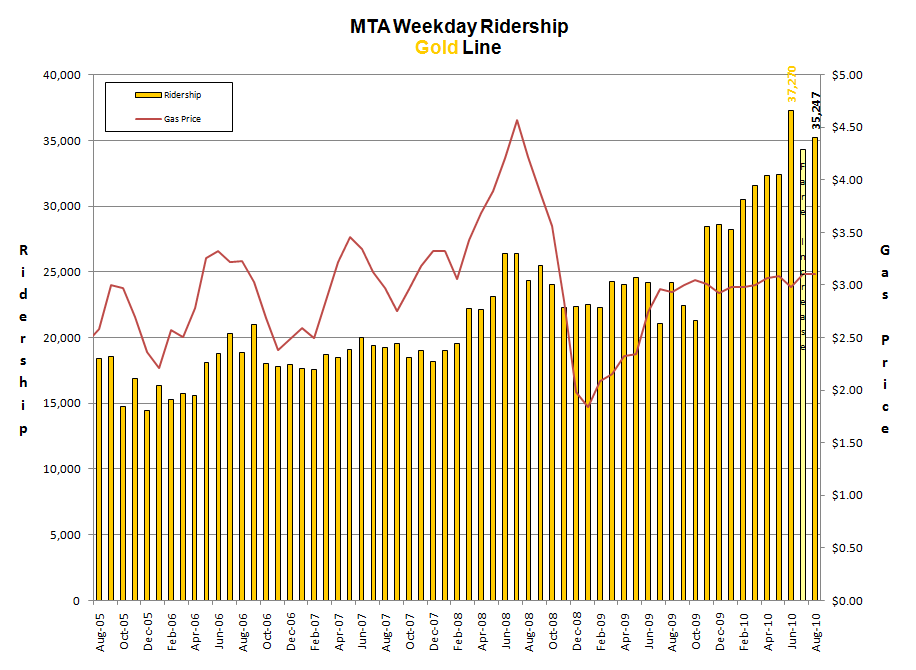 |
|
|
|
Post by rubbertoe on Oct 15, 2010 7:41:55 GMT -8
September numbers are out today. Total light rail ridership was down about 1,000 from the previous month. The Orange Line, strangely enough, popped from 21,694 up to 25,052. A level not seen since late 2008. Not sure whats up there. In any case, the Gold Line up trend is still looking very good. The EE was the only "extension" to be opened since the last Red Line extension if memory serves me correctly. Hopefully other extensions will have similar results, with the Expo Phase 2 being the next one up, or possibly the GLFE. 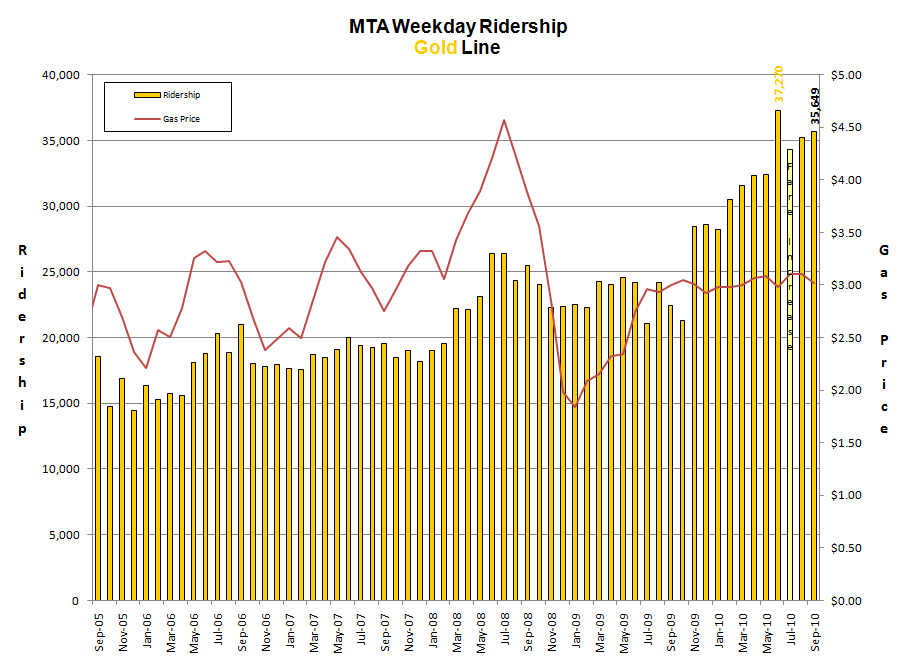 |
|
|
|
Post by jdrcrasher on Oct 15, 2010 14:56:51 GMT -8
Despite the fare increase, the ridership remained unchange. This is very encouraging.
|
|
|
|
Post by jamesinclair on Oct 16, 2010 14:09:14 GMT -8
Its amazing how stable the gas prices have been, no seasonal changes at all.
|
|
|
|
Post by rubbertoe on Jan 25, 2011 7:56:06 GMT -8
The final 2010 end of year numbers for December. 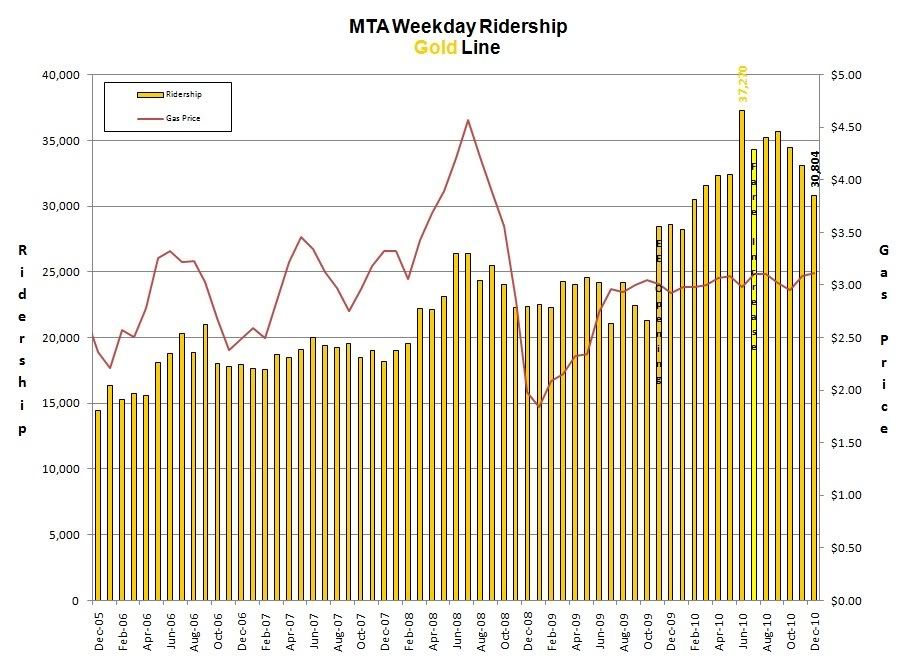 |
|
|
|
Post by metrocenter on Jan 25, 2011 11:30:43 GMT -8
Quoting myself from another thread: Judging from the graphs, it looks like the EE has added about 13,000 new riders to the line, in its first year of operation.
According to the EIR, the extension is supposed to have 16,000 boardings by 2020. So it's not doing too badly. |
|
|
|
Post by rubbertoe on Apr 12, 2011 15:13:00 GMT -8
March numbers just released today. End of quarter so I will post all the individual graphs for all the lines: 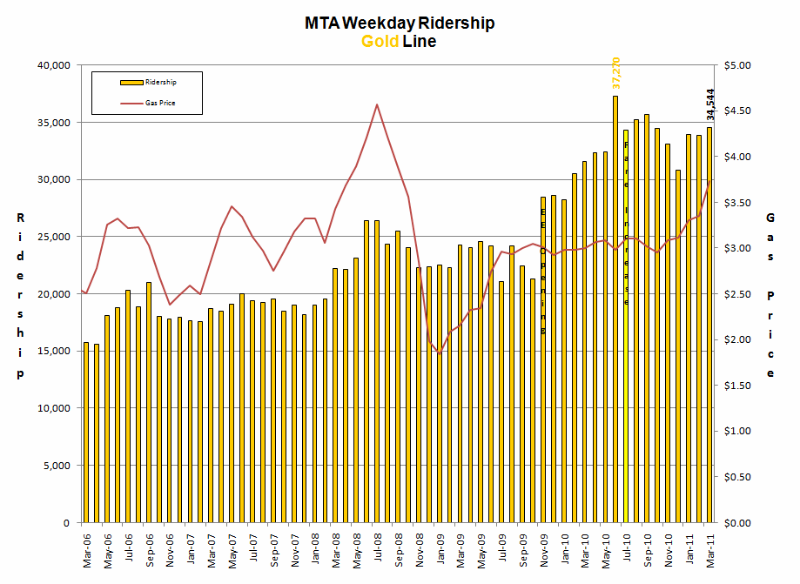 Something that I noticed in the raw data is that there is almost always a jump in ridership from January to February. The Gold Line saw this, but the Blue and Green were both down. Also of note, gas has started the big rise right after the December chart was posted. More notes in the combined ridership topic. RT |
|
|
|
Post by rubbertoe on Jul 13, 2011 16:29:05 GMT -8
June numbers are out, time for the quarterly graph update:  Some very good news for the Gold Line too. Ridership hit a new all time high at 39,112. The YOY increase was only 1,842, but that is compared to the insanely high spike that came in June 2010. The fare increase in July 2010 then brought the number back down. The combined light rail ridership also hit an all-time high, more on that in the combined thread. RT |
|
|
|
Post by masonite on Jul 13, 2011 20:51:43 GMT -8
Nice to see the Gold Line starting to live up to expectations. Reduced headways in July should help even more, especially since I know some Gold Line riders get easily frustrated if they don't get a seat. Does anyone here ride the Gold Line on a consistent basis? If so, is the increase coming from the Eastside to a large extent. I know traditionally, this line had pretty low ridership past Little Tokyo. Is that changing now that the Eastside has been open nearly two years with more balanced loads across the line?
|
|
|
|
Post by rubbertoe on Oct 12, 2011 16:23:55 GMT -8
September numbers are out, and hence the quarterly update: 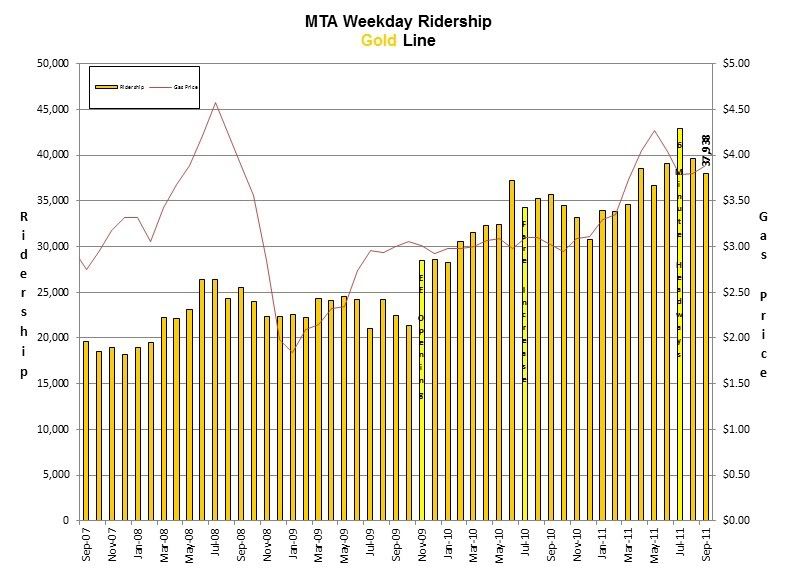 The 6 minute headways did indeed provide a huge boost, especially in July. That month had the highest ridership ever at 42,900, but Excel won't let me add another label to that column since it already has "6 minute headways" as the label, otherwise I would have shown the high ridership as the header. I also changed the graph to only be 4 years instead of the last 5. You still get a very good idea of the trends over time, without it being such an eye chart. Especially given the 800 pixel maximum horizontal resolution. More discussion in the Combined Ridership thread... RT |
|
|
|
Post by rubbertoe on Jan 19, 2012 7:18:26 GMT -8
December end of year ridership chart: 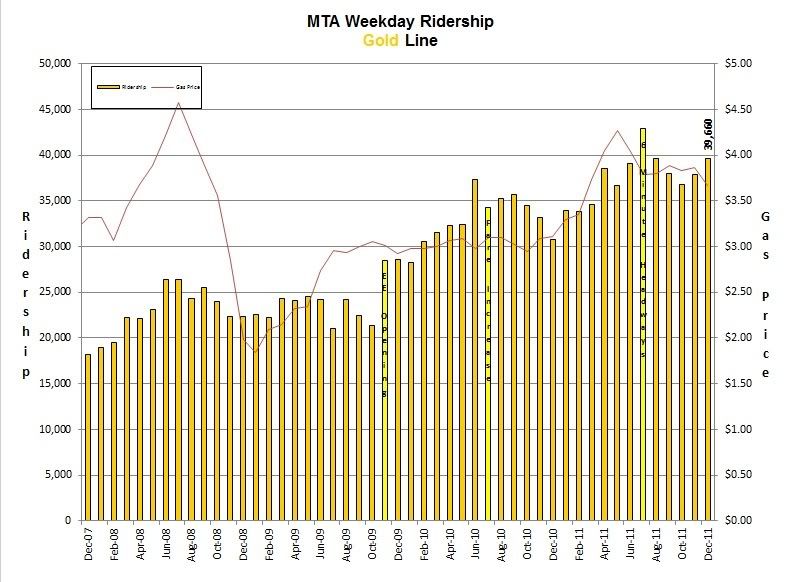 And a quick shot of the timetable, showing the 6 minute headways that were implemented back in July 2011:  Thought I would elaborate a bit more since it is the end of the year, and the Gold Line is doing so well. Plus as we have seen from the recent DC FEIR, the Gold Line will at some point no longer exist in it's current form, being replaced by the East-West and the North-South service that the DC will bring. The timetable shows that they are now running with 6 minute headways during the morning and evening rush hours. There are 129 Southbound trains every weekday, and 137 Northbound trains. The first and last trains are scheduled for 3:40am, and 1:09am respectively. The other thing that stands out looking at the end of year data, is the unusual rise going into December. Normally December or January is the low point, but this year showed strong numbers with increasing ridership for both November and December. As pointed out in the combined ridership thread, the Gold Line for the first time has more riders than the Green Line. Looking ahead several years, The Foothill Extension could possibly be opening before the DC reconfiguration that will sever the link between the LT station and Union Station. In terms of the expansion of the line, that will be the last length increase before the N/S and E/W reconfiguration, and should see another large ridership increase. RT |
|
|
|
Post by Gokhan on Jan 19, 2012 10:46:44 GMT -8
I would like to point out that gas prices have no effect over the long run on transit ridership. Even with $20 per gallon, driving habits wouldn't change over the long run. Gas prices only affect the transit ridership in the short run and eventually people adjust to higher prices and change back to their normal driving habits.
Probably the only way to promote transit ridership is to build more and better transit -- more high-quality rail lines that is.
|
|
|
|
Post by LAofAnaheim on Jan 19, 2012 13:10:01 GMT -8
I would like to point out that gas prices have no effect over the long run on transit ridership. Even with $20 per gallon, driving habits wouldn't change over the long run. Gas prices only affect the transit ridership in the short run and eventually people adjust to higher prices and change back to their normal driving habits. Probably the only way to promote transit ridership is to build more and better transit -- more high-quality rail lines that is. .......and make parking/driving less convenient. Driving/parking is much more convenient in Los Angeles than any other major world-class city. When people in SF complain they cannot find a spot in 40 minutes.....that includes ALL nearby parking garages for $20. In LA, when people complain they cannot find a spot in 40 minutes.....it's because they avoid paying more than $5 in a parking garage to park. Adjust the parking minimums to maximums and cap parking in certain dense districts. Then you'll see people using transit. And the whole myth "well, nobody will come" is absolutely false. As people still make their way to the inner core for cultural institutions, events, etc... Why is Hollywood/Venice/Downtown LA still more popular than the Valley with its miles and miles of free parking? |
|
|
|
Post by joemagruder on Jan 19, 2012 13:28:12 GMT -8
The goal shouldn't be to make other modes less convenient, etc. but to make transit more convenient. When I get on BART to travel to San Francisco I know that I won't have to wait more than 8 minutes for a train, that the trip will take 30 minutes, that I can read or finish my crossword during the trip... That's better than driving, even if I knew that I could find a $1 parking spot within 50' of the door in San Francisco.
|
|
|
|
Post by masonite on Jan 19, 2012 13:53:41 GMT -8
I would like to point out that gas prices have no effect over the long run on transit ridership. Even with $20 per gallon, driving habits wouldn't change over the long run. Gas prices only affect the transit ridership in the short run and eventually people adjust to higher prices and change back to their normal driving habits. Probably the only way to promote transit ridership is to build more and better transit -- more high-quality rail lines that is. .......and make parking/driving less convenient. Driving/parking is much more convenient in Los Angeles than any other major world-class city. When people in SF complain they cannot find a spot in 40 minutes.....that includes ALL nearby parking garages for $20. In LA, when people complain they cannot find a spot in 40 minutes.....it's because they avoid paying more than $5 in a parking garage to park. Adjust the parking minimums to maximums and cap parking in certain dense districts. Then you'll see people using transit. And the whole myth "well, nobody will come" is absolutely false. As people still make their way to the inner core for cultural institutions, events, etc... Why is Hollywood/Venice/Downtown LA still more popular than the Valley with its miles and miles of free parking? I def. agree. Parking is a bigger determinate of whether one will take transit. In fact, even though I live near Bundy, I plan to utilize Expo on occasion for going Downtown and to SC football games and such. Mostly because parking is difficult and often expensive in these locations. We mandate too much parking in LA. There is a great article in LA Magazine about this. Even about how Disney Hall is basically just a building on top of a large very expensive parking garage and that the parking garage built by the County mandated that the Concert Hall have a certain number of events to make the garage somewhat economical. It is totally backwards. Even now, I walk to work - a little over a half mile and I am not sure I always would if I didn't get the parking incentive refunded back to me. |
|
|
|
Post by LAofAnaheim on Jan 19, 2012 14:12:51 GMT -8
The goal shouldn't be to make other modes less convenient, etc. but to make transit more convenient. When I get on BART to travel to San Francisco I know that I won't have to wait more than 8 minutes for a train, that the trip will take 30 minutes, that I can read or finish my crossword during the trip... That's better than driving, even if I knew that I could find a $1 parking spot within 50' of the door in San Francisco. If you could find parking for $1 in San Francisco.........MORE people would find driving convenient than transit. In LA you can find that spot 50' away for $4 - $6......you cannot in SF, that's the difference. Even though its taboo, it truly is parking convenience that kills transit ridership. Look at the parking situation in New York, Chicago, London, Paris, Tokyo, etc... Those parking garages are a standard $20 MINIMUM. In LA, parking garages are generally $6 - $15 and some of them offer free parking with validation. Find the comparables in the other major cities, then you're talking apples-apples. You can make the most efficient transit system, but if you are giving parking subsidies, abundant parking, free parking, etc........everybody is going to think twice about transit. In those aforementioned cities, that option is barely there. Fix the parking convenience, then transit ridership will increase. |
|
|
|
Post by masonite on Jan 19, 2012 14:26:11 GMT -8
Also, it is important to note how parking in a certain area will affect transit ridership and I am not sure our ridership models always pick this up. For example, traffic is much worse going west on the SM freeway in the morning and vice-versa in the afternoon. However, I expect transit ridership will be more even than the car traffic due to the fact that people working downtown will have much more of an incentive to avoid parking as workers downtown often have to pay for their own parking.
In West LA, the destinations are more spread around and are not really on the Expo Line. Parking is easy and cheap (free for workers in almost all cases), and the neighborhoods generally discourage walking through their design to promote cars over all other forms of transport.
This is why I tend to think the Gold Line will struggle as it goes farther east. People say the 210 traffic is tough, but parking in Pasadena is pretty easy and once they realize they have to walk from a freeway station to their destination if they are going to Lake for example, it is going to be hard to compete with travel by car where they can park in the garage directly next to their building/destination.
Of course, time is still very key. People won't double their commutes in most cases to save a few dollars on parking. However, if the times are comparable they often will.
|
|
|
|
Post by jamesinclair on Jan 19, 2012 20:12:39 GMT -8
I would like to point out that gas prices have no effect over the long run on transit ridership. Even with $20 per gallon, driving habits wouldn't change over the long run. Gas prices only affect the transit ridership in the short run and eventually people adjust to higher prices and change back to their normal driving habits. Thats a ridiculous statement. There are countless people who dont have the luxury of being able to afford a $40 daily commute*. Its not about sticker shock for most transit riders, its about making ends meet. *20 miles commute in a car getting 20mpg = 1 gallon each way. 2 gallons at $20 each would mean $40 a day. And its not just $20, its $10 and yes $5 a gallon. |
|
|
|
Post by Justin Walker on Jan 19, 2012 21:43:27 GMT -8
.......and make parking/driving less convenient. Driving/parking is much more convenient in Los Angeles than any other major world-class city. When people in SF complain they cannot find a spot in 40 minutes.....that includes ALL nearby parking garages for $20. In LA, when people complain they cannot find a spot in 40 minutes.....it's because they avoid paying more than $5 in a parking garage to park. Adjust the parking minimums to maximums and cap parking in certain dense districts. Then you'll see people using transit. And the whole myth "well, nobody will come" is absolutely false. As people still make their way to the inner core for cultural institutions, events, etc... Why is Hollywood/Venice/Downtown LA still more popular than the Valley with its miles and miles of free parking? The goal shouldn't be to make other modes less convenient, etc. but to make transit more convenient. When I get on BART to travel to San Francisco I know that I won't have to wait more than 8 minutes for a train, that the trip will take 30 minutes, that I can read or finish my crossword during the trip... That's better than driving, even if I knew that I could find a $1 parking spot within 50' of the door in San Francisco. It's not about making driving less convenient, it's about making the true costs of transportation choices apparent to travelers (i.e. internalizing the true costs of driving). Currently, Los Angeles and many other cities have requirements that businesses and residential complexes provide a large amount of off-street parking, usually free to motorists. The costs of building and maintaining parking are passed on to all customers (including those that don't drive) in the form of higher costs for all goods and services. Driving also has social costs, including traffic congestion and pollution, but travelers are rarely forced to think about them. See this diagram from Transportation for Livable Cities:  See also Donald Shoup's work to eliminate damaging parking policies such as off-street parking requirements and underpriced curb parking. |
|
|
|
Post by matthewb on Jan 20, 2012 2:01:23 GMT -8
I would like to point out that gas prices have no effect over the long run on transit ridership. Even with $20 per gallon, driving habits wouldn't change over the long run. Gas prices only affect the transit ridership in the short run and eventually people adjust to higher prices and change back to their normal driving habits. Thats a ridiculous statement. There are countless people who dont have the luxury of being able to afford a $40 daily commute*. Its not about sticker shock for most transit riders, its about making ends meet. *20 miles commute in a car getting 20mpg = 1 gallon each way. 2 gallons at $20 each would mean $40 a day. And its not just $20, its $10 and yes $5 a gallon. I've long heard that higher gas prices in Europe are considered to be one of the factors that leads to higher public transportation usage. Also, I've read that people who switch to public transportation in the US, possibly because of sticker shock, tend to keep using public transportation even if gas prices go down later. One analysis is here. |
|
|
|
Post by Gokhan on Jan 20, 2012 11:05:05 GMT -8
I would like to point out that gas prices have no effect over the long run on transit ridership. Even with $20 per gallon, driving habits wouldn't change over the long run. Gas prices only affect the transit ridership in the short run and eventually people adjust to higher prices and change back to their normal driving habits. Thats a ridiculous statement. There are countless people who dont have the luxury of being able to afford a $40 daily commute*. Its not about sticker shock for most transit riders, its about making ends meet. *20 miles commute in a car getting 20mpg = 1 gallon each way. 2 gallons at $20 each would mean $40 a day. And its not just $20, its $10 and yes $5 a gallon. But, in the long run, people find a way of balancing their budget and switch back to driving. Gas prices were only $1 a gallon in the late 90s and only $2 gallon until a few years ago. Now, it's $4 a gallon. Did it affect the transit use? Not really. In Europe, you can see this more dramatically. In Istanbul, for example, where I visit every year, gas is roughly 2.5 times as here -- $10 a gallon that is -- due to gas taxes. Cars are also a lot more expensive to buy. Parking is also a lot more expensive -- you need to pay for residential parking often. On top of that, the income levels are lower. Yet, on top of that, the public-transit system is better. It's not to say that public transit isn't heavily used there, but the increase in driving habits every year is very dramatic. A lot of people there drive to work now, despite very congested freeways, highways and roads. Urban sprawl is also contributing a lot to increased driving. My main point is that nothing will stop people from loving their cars and the whole rhetoric about how gas prices matter has nothing to do with reality at all. I do support higher gas taxes: (1) It will really not hurt people that much. (2) It will make people to switch to more fuel-efficient cars. (3) It will help finance useful projects, such as building quality rail transit. (4) It will also partially get absorbed by the oil companies, driving their selling prices lower to keep the demand. |
|
|
|
Post by matthewb on Jan 20, 2012 16:52:17 GMT -8
Thats a ridiculous statement. There are countless people who dont have the luxury of being able to afford a $40 daily commute*. Its not about sticker shock for most transit riders, its about making ends meet. *20 miles commute in a car getting 20mpg = 1 gallon each way. 2 gallons at $20 each would mean $40 a day. And its not just $20, its $10 and yes $5 a gallon. But, in the long run, people find a way of balancing their budget and switch back to driving. Gas prices were only $1 a gallon in the late 90s and only $2 gallon until a few years ago. Now, it's $4 a gallon. Did it affect the transit use? Not really. In Europe, you can see this more dramatically. In Istanbul, for example, where I visit every year, gas is roughly 2.5 times as here -- $10 a gallon that is -- due to gas taxes. Cars are also a lot more expensive to buy. Parking is also a lot more expensive -- you need to pay for residential parking often. On top of that, the income levels are lower. Yet, on top of that, the public-transit system is better. It's not to say that public transit isn't heavily used there, but the increase in driving habits every year is very dramatic. A lot of people there drive to work now, despite very congested freeways, highways and roads. Urban sprawl is also contributing a lot to increased driving. My main point is that nothing will stop people from loving their cars and the whole rhetoric about how gas prices matter has nothing to do with reality at all. I do support higher gas taxes: (1) It will really not hurt people that much. (2) It will make people to switch to more fuel-efficient cars. (3) It will help finance useful projects, such as building quality rail transit. (4) It will also partially get absorbed by the oil companies, driving their selling prices lower to keep the demand. Money isn't the only issue, but it is one of them. Here is a list from Jarrett Walker of issues that affect people's decisions whether to take transit: 1. “It takes me where I want to go.” 2. “It takes me when I want to go.” 3. “It’s a good use of my time.” 4. “It’s a good use of my money.” 5. “It respects me.” 6. “I can trust it.” 7. “It gives me freedom to change my plans.” Point 4 is an issue, but it's not the only one. For many people, the other 6 axes favor driving over transit. I don't know it's so much a matter that people "love" their cars, but until transit satisfies all these points for a reasonable percentage of the population, many people might find that driving is the better option. Nevertheless, as I posted above, there is evidence that people do take transit more when gas prices are higher. Long term ridership is up on all rail lines at least, as is well documented by rubbertoe (thanks). I'm not sure where your conclusions are coming from, especially how you attribute peoples motivations. Do you have any data to support these conclusions? |
|
|
|
Post by rubbertoe on Jan 24, 2012 12:32:17 GMT -8
I would like to point out that gas prices have no effect over the long run on transit ridership. Even with $20 per gallon, driving habits wouldn't change over the long run... It will of course increase the transit ridership in the short run if you increase the gas prices. But, in the long run, people find a way of balancing their budget and switch back to driving. Gas prices were only $1 a gallon in the late 90s and only $2 gallon until a few years ago. Now, it's $4 a gallon. Did it affect the transit use? Not really. Gokhan, I combined a couple of your quotes, shown above. I actually thought that you were joking when I first read that, apparently not  I would like to see any documented research you can point me to that shows that higher gas prices do not deter people from driving, especially if that research shows that $20 per gallon gas has no long term effect on driving behavior. Basic laws of supply and demand state that any time you increase the cost of something that people want, demand will go down. Recent research has shown that Americans driving miles are decreasing. This has been going on for several years. If I'm to believe your hypothesis, then this isn't attributable to higher gas prices, what would be causing it then? Someone making $10 per hour and living 25 miles from work is grossing $80 per day, and paying (assume 20mpg car) $5.00 per day for gas if gas cost $2.00 per gallon. If gas cost $5.00 per gallon, they would be paying $12.50 per day, or 15% of their gross pay. Thats a big incentive to take the bus, and that cost doesn't even include basic insurance and maintenance. Per my ridership spreadsheet, between Nov-06 and Jul-08, gas went from $2.38 to $4.57. Combined ridership(rail plus Orange Line) from July-07 to July-08 went from 290,000 to 341,000. Of course, that is a short term trend, but you said that even if prices stayed that high, people would return to their cars eventually. So, are you saying that if gas prices were to stay that high (~$5.00) that transit ridership would go down over time?  I have seen articles pointing out that people are waiting longer to get their drivers licenses, and also that the recession has prevented many people who are out of work from driving as much. Also, I have seen articles stating that driving isn't as important to 20-somethings if they can get around where they want to go without a personal vehicle. None of these make any kind of case for "people switching back to driving". 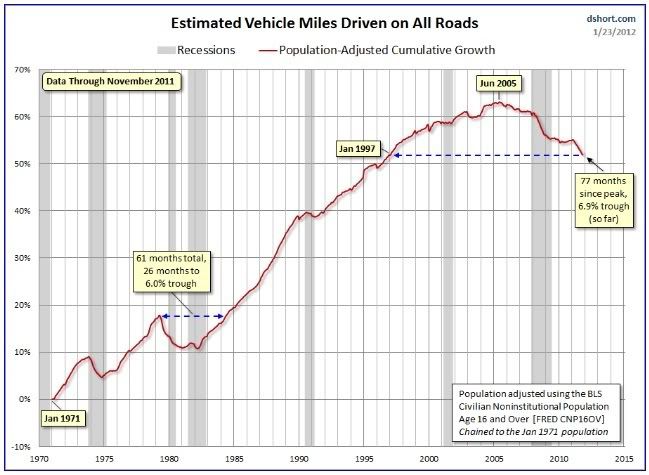 RT |
|
|
|
Post by jamesinclair on Jan 24, 2012 13:43:50 GMT -8
It will of course increase the transit ridership in the short run if you increase the gas prices. But, in the long run, people find a way of balancing their budget and switch back to driving. By balancing their budget, do you mean quitting their job? If you make $100 a day, and you spend $40 a day in gas....you either take transit or quit your job and take the welfare check because that brings home more money than driving to a job when gas is $20 a gallon. Going from $1 a gallon to $2 may be a 100% price increase, but it's still below the critical point. 20 mile commute, 20mpg car = going from $2 a day to $4 a day....which just so happens to be less than transit! Thats $2 sucks, but it can be one. Double again to $4 and now youre spending $8 a day. High, but not crippling, you can still cut other costs. But more than $10 a day in gas costs alone? Thats just not even possible for most transit riders. If you make $100,000 a year, then $10-$20 a day isn't that much. If you make $10,000 a year, it's devastating. |
|
|
|
Post by masonite on Jan 24, 2012 13:50:14 GMT -8
I am going to defend Gokhan somewhat here.
First of all, cost of transportation options has some effect on which modes are taken, but not necessarily as much as everyone thinks and gasoline price is often a relatively small portion of the cost of car commuting (parking costs are often as big or even bigger determinite). If gas prices stay high for a while, people can just as easily switch out for a smaller more fuel efficient car and they can end up spending less on gas driving the same amount than when gas cost less than $2.00 per gallon. Look at Metrolink ridership for an example. It is well below its all time high and hasn't really gone anywhere for 7-8 years even though its riders travel long distances and tend to live almost wholly in the suburbs.
Americans are a little crazy when it comes to gas prices. They think they are entitled to cheap gas and when it goes up 10 cents a gallon, the end of the world is coming. Yet they largely still pay it. Remember not too long ago when gas was less than $2.00 and Europeans were paying over $4.00. Everyone thought that Europeans almost had to use public transport because gasoline was so expensive. Well, we are basically there and still don't use transit in anywhere near the numbers that Europeans did at that level (due to several causes including inadequate transit).
Rubbertoe cited Gen Y as shunning cars and going to transit somewhat. That is true, but it is not really due to gas prices as he says. Americans were already starting to drive less before gas prices spiked. Cities haven been on a revitalization roll the last decade and living in the suburbs and driving everywhere has become uncool over the that time. Throw in smartphones and tablets that Gen Y embraces and the fact that they can use them in transit but not really in their cars (although I see many people driving and doing just this).
IMHO, bottom line is the gas price effect on transit is overstated and other factors are understated.
|
|
|
|
Post by rubbertoe on Jan 24, 2012 15:18:34 GMT -8
Here is a CBO study from 2006, that looked at gas price increases from $2.50 to $3.00: www.cbo.gov/ftpdocs/88xx/doc8893/Chapter1.5.1.shtmlAnd the relevant ridership paragraph: Reductions in traffic volume correspond closely to increases in transit ridership. CBO analyzed monthly ridership totals for the municipal light-rail systems in Sacramento, Los Angeles, and San Diego and for the subway systems in Los Angeles and the San Francisco Bay Area. (In order to combine the data from different-sized transit systems into the same analysis, CBO expressed each system’s ridership as a percentage of its average in a baseline period—the same treatment it applied to freeway traffic volumes.) Adjusting for long-term ridership trends on each system, seasonal effects, and inertia (the tendency for ridership totals to persist from one month to the next), CBO estimates that the same increase of 20 percent in gasoline prices that affects freeway traffic volume is associated with an increase of 1.9 percent in average system ridership. That result is moderately statistically significant: It can be asserted with 95 percent confidence that higher gasoline prices are associated with increased ridership.
For an average-sized system, that result translates into about 1,870 additional rail trips per day in each direction, throughout the system.8 For a transit system that has several branches running alongside freeways—as the systems in CBO’s sample have—that implies an additional 625 to 935 riders per line for systems with, respectively, three or two such lines. Thus, as gasoline prices have increased, the average number of riders gained by the rail transit systems in CBO’s sample has been reasonably consistent with the reduction in the number of vehicles per weekday, about 730, on the adjacent freeways. In CBO’s analysis, all five transit systems exhibited positive relationships between ridership and gasoline prices, although for the two (interconnected) Los Angeles systems, the effect was small and not statistically different from zero.So, at least for the $2.50 to $3.00 price range, less vehicle volume equates to about a 2% ridership increase in areas where light rail or rapid transit is available. There is a correlation, but not much of one. Certainly not enough to explain the Gold Line increases. Of course, the pain of higher prices isn't necessarily linear either. There is a difference between a $2.50 to $3.00 price, and a $3.00 to $4.50 price. The prior paragraph showed that weekday traffic volume on rail adjacent freeways decreased by 0.69%. Again, a small decrease. They don't provide the actual massaged numbers that they used to come up wit the 2.0% rail increase. The interesting thing is that when you look at the raw data from the 2005-06 period, all the LA rail lines were generally showing 10%+ YOY growth, often it was over 20%. The YOY comparison takes out the seasonality, but they also say that they are adjusting for "long term trends". Thats likely why they came up with smaller numbers than the actual increases. I guess if ridership is going up 10% a year anyway, then you can't really attribute the 10% to gas prices. Having said that, I don't see how you can differentiate between "long term trends" and what is attributable to the effect of gas prices, since gas prices are fluctuating at all times, even when calculating the "long term trend". I will look for more recent studies that look at say the 2008-9 time frame. RT |
|
|
|
Post by rubbertoe on Jan 24, 2012 15:29:51 GMT -8
|
|